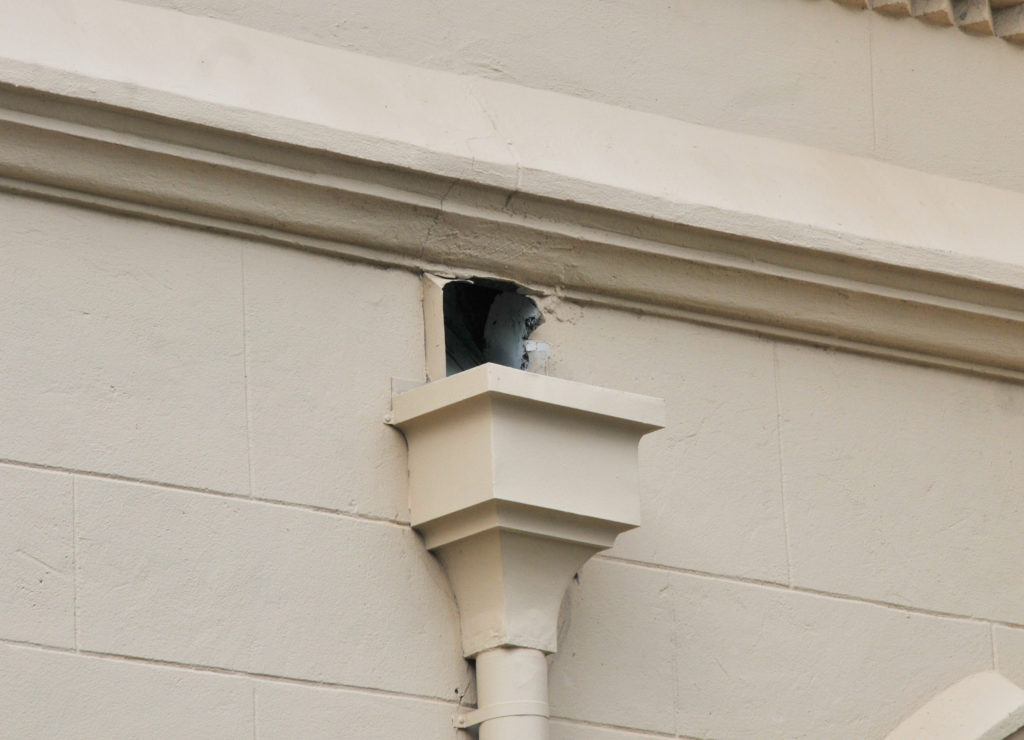Resilience Treatments & Strategies
Roof Attachments

Description
Includes components that connect to the roof to provide drainage, such as gutters, exterior downspouts, scuppers, and associated hardware. These usually connect to a stormwater system or drain out to a public street.
Also includes components that penetrate the roof surface, such as dormers, skylights, vents, chimneys, and hatches. These can affect the structural behavior of your roof and need consideration for proper drainage of water from the roof.
Typical risk factor of this component:
Moderate
Roof attachments are very exposed to elements such as wind and rain. However, they have negligible importance to the structure’s stability and their failure generally has little to no immediate impact on other assemblies. Over time, dysfunctional roof drainage systems will result in damage to other building assemblies.
Typical Damages from Floods or Hurricanes
- Downspouts missing or do not lead directly to splash blocks or a subgrade drainage system
- Leaking, rusting, or otherwise failing gutters, downspouts, or connections
- Moisture around downspouts
Other common conditions contributing to vulnerability towards floods or hurricanes
- Undersized drainage ports handling water shedding for roof
- Lack of overflow drainage
- Galvanic corrosion occurring between metal roof components
- No way to direct water away from building
- Gutters blocked with debris such as leaves
- Lack of crickets or flashing around roof penetrations such as chimneys
Resilience Treatments and Strategies
In-house
Adjust downspouts so that water flows into the drainage system, or replace if necessary (in-kind, may need an architect in this case).
Repair any leaking/damaged gutters, downspouts, and their connections.
Install splash blocks or use other methods to convey rainwater away from the building without causing soil erosion.
Inspect, clean, and repair all gutters and downspouts annually (see also NPS Preservation Brief #47).
Professional needed [type]
Adjust size and layout of drainage system to properly shed water and protect roof structure [architect].
Install subgrade drainage system [landscape architect or architect].
Roof Attachments

Description
Includes components that connect to the roof to provide drainage, such as gutters, exterior downspouts, scuppers, and associated hardware. These usually connect to a stormwater system or drain out to a public street.
Also includes components that penetrate the roof surface, such as dormers, skylights, vents, chimneys, and hatches. These can affect the structural behavior of your roof and need consideration for proper drainage of water from the roof.
Typical risk factor of this component:
Moderate
Roof attachments are very exposed to elements such as wind and rain. However, they have negligible importance to the structure’s stability and their failure generally has little to no immediate impact on other assemblies. Over time, dysfunctional roof drainage systems will result in damage to other building assemblies.
Typical Damages from Floods or Hurricanes
- Downspouts missing or do not lead directly to splash blocks or a subgrade drainage system
- Leaking, rusting, or otherwise failing gutters, downspouts, or connections
- Moisture around downspouts
Other common conditions contributing to vulnerability towards floods or hurricanes
- Undersized drainage ports handling water shedding for roof
- Lack of overflow drainage
- Galvanic corrosion occurring between metal roof components
- No way to direct water away from building
- Gutters blocked with debris such as leaves
- Lack of crickets or flashing around roof penetrations such as chimneys
Resilience Treatments and Strategies
In-house
Adjust downspouts so that water flows into the drainage system, or replace if necessary (in-kind, may need an architect in this case).
Repair any leaking/damaged gutters, downspouts, and their connections.
Install splash blocks or use other methods to convey rainwater away from the building without causing soil erosion.
Inspect, clean, and repair all gutters and downspouts annually (see also NPS Preservation Brief #47).
Professional needed [type]
Adjust size and layout of drainage system to properly shed water and protect roof structure [architect].
Install subgrade drainage system [landscape architect or architect].